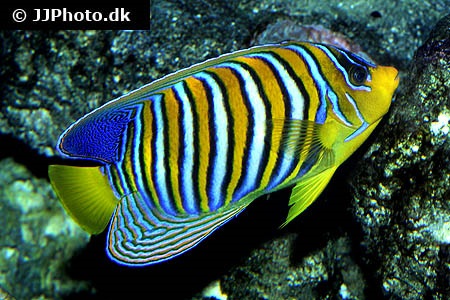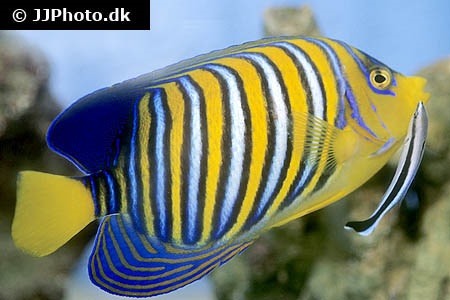Pygoplites diacanthus
| Latin name | Pygoplites diacanthus - (Boddaert, 1772) |
|---|---|
| Local name | Regal angelfish |
| Family | Pomacanthidae - Pygoplites |
| Origin | East Indian Ocean, West Indian Ocean, Australia, The Red Sea, Indonesia, East Pacific, Central/West Pacific |
| Max length | 24 cm (9.4") |
| Minimum volume |
900 l (237 gal) |
|---|---|
| Hardiness |
Delicate |
| Suitable for aquarium |
Experience, preparation and extra care required |
| Reef safe |
Not reef safe |
| Aggressiveness | Might be aggressive towards other species |
| Recommended |
Larger crustaceans (Shrimp, crabs...) Macroalgea (Eg. seaweed / nori) Microalgea (Eg. spirulina) Other invertebrates Small crustaceans (Krill, mysis, artemia...) Sponges |
|---|---|
| Maybee |
Large polyp stone coral (LPS) Small polyp stone coral (SPS) Soft coral Zooplankton (Cyclops, pods...) |
This species sometimes nibbles at clams including Tridacna species.
Hard to give this species the correct nutrition and is therefore hard to keep alive.
This species demands a high water quality.
Amongst other things it means, that water must be properly oxygenated.
This fish can be very fastidious and therefore hard to get it feeding in an aquarium.
Try to feed it live Mysis shrimp, fresh mussels and the like, if at first it refuses to eat.
This species must be fed with an appropriately varied diet.
This species is very sensitive during transportation and acclimatizing into the aquarium.
This fish requires feeding several times a day, especially when newly added.
When the fish can find its natural food in the aquarium it requires less frequent feeding.
These fish should be kept in a well run aquarium where they can "graze" algae from rocks and stones.
If there are insufficient algae on the rocks, it is important to feed more frequently and supplement with algae rich food e.g. Spirulina.
This species needs good hiding places, for example, between live rocks.
This species revels in swimming and requires an aquarium with ample space.
This species is very shy and docile, so one should be careful when keeping it with more aggressive fish.
This species can change gender from female to male.
When a male is needed, a female changes sex and takes on the role.
This species can be aggressive when kept together with fish that are very similar, or if they are not provided with adequate space.
It can be a challenge to keep corals together with Angelfish, since the latter eat most soft corals and LPS. Especially Zoathus are swiftly eaten by the larger species.
It is however possible to build up a mixed coral aquarium with Angelfish. If some of the following corals are choosen there is a good chance the Angelfish will leave them alone; Hammer corals, Bubble corals, Star polyps, Disc anemones and others.
Most of the SPS corals can be kept with Angelfish.
It is possible to keep various different sizes of Angelfish in the same aquarium, but it means that one must choose species with care and that the conditions in the tank are optimum.
Here are some suggestions to increase the chances of success:
Choice of species
It is important not to choose species that are too similar, the greater the variance, the larger the chance of success. It is also advantageous to choose fish of different sizes. Two young Angelfish of the same same size and pattern for example are a bad idea. One should of course avoid the most aggressive species.
Order of introduction
It is a good idea to make a wishlist and choosing the order so, that the least aggressive are introduced first. When adding similar sized Ange fish it works best if they are introduced simultaneously.
Space
There should be enough space in the aquarium, but it is difficult to give specific advice. Of course there are exceptions to the table below as to just how big a tank should be in order to stand a good chance of success. Space itself is not enough, there should also be sufficient hiding places so the fish do not have to fight over these.
100 gal (400 liters): Several small Angelfish (<15cm) can live together.
240 gal (900 liters): Several medium Angelfish (< 20cm) can live together.
400 gal (1500 liters): Several large Angelfish (<25cm) can live together.
Food and water quality
It is always helpful to give the fish a varied diet, so they can withstand the occasional stress situation when for example new fish are introduced. Water quality must also be very high, so that the fish do not get stressed for that reason either.
The varieties from the Red Sea have yellow chests whereas the others have greyish or blue ones.
In order to survive in the aquarium, the fish should be alert, healthy and without any obvious injuries to their scales and fins.
There is only one species in the Pygoplites genus and it is known for its extraordinary attractive colours, but they are shy, especially in an tank with bright light. They are not reef safe.
It is a difficult species to keep in an aquarium due to its reluctance to eat in captivity. It is vital that these fish also get Spirulina or nori seaweed, as part of their diet.
Angelfish (Pomacanthidae) are known as some of the most colourful and impressive fish on the reef.
Many species are not reef safe, as they especially target the soft corals and LPS. But by choosing your corals carefully, or by getting specific species of Angelfish, they can be kept in coral aquariums.
There are Angelfish suitable for most aquarium sizes, from Dwarf Angelfish which are well suited to smaller aquaria, to the larger of the species which can be impressively displayed in a larger aquarium.
The demands of the individual species can vary widely. Some are food specialists and require therefore special food, while for others can be difficult to acclimatize, as they live in deep water in the wild. It is recommended that one has a reasonably good knowledge of the different types of food and of treatments of illnesses, if one wishes to keep the larger species.
| Aquarium trade | Yes |
|---|---|
| Distribution | Indo-Pacific: Red Sea and East Africa to the Tuamoto Islands, north to Ryukyu and Ogasawara islands, south to the Great Barrier Reef and New Caledonia. |
| English common names |
Royal angelfish Regal angelfish |
| Danish common names |
Påfuglekejserfisk |
| German common names |
Pfauenkaiserfisch |
| French common names |
Poisson-ange duc |
Stan & Debbie Hauter. 2015. Regal Angelfish (Pygoplites diacanthus) - Profile and Care Information - The Spruce - (English)
Niels K. 2014. Private conversation - saltvandsforum.dk - (Danish)
Scott W. Michael. 2004. Angelfishes and Butterflyfishes (Reef Fishes Series Book 3) TFH Publications / Microcosm Ltd. - (English)
Bob Fenner. Marine Angelfishes, Family Pomacanthidae - Wet Web Media - (English)
Bob Fenner. The Best Angelfishes For Marine Aquarium Use - Wet Web Media - (English)
Bob Fenner. The Ultimate Angelfish Aquarium; An amazing and challenging collection of marine angelfishes - Wet Web Media - (English)
Collection of links to additional information - Wet Web Media - (English)
Reef Central. 2009. Keeping more than one emperor angelfish together - (English)




